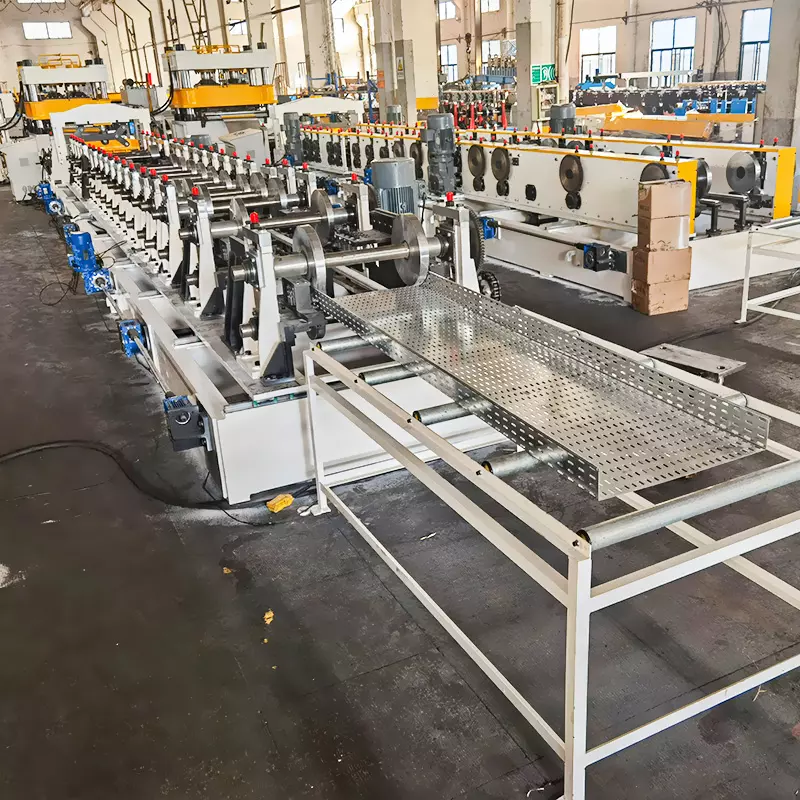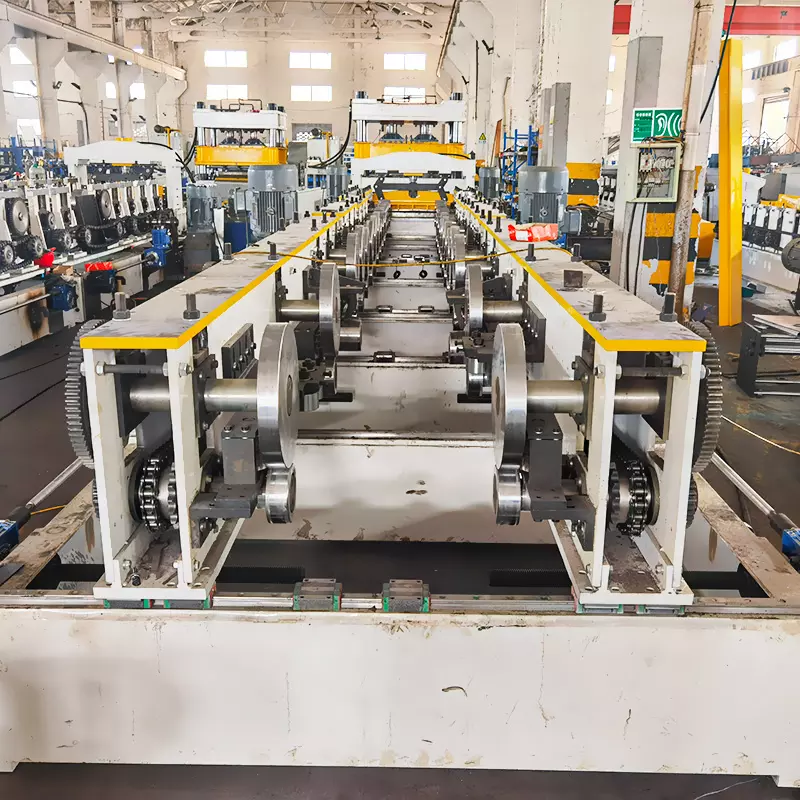Introducción
Cuando se trata de metal forming, two of the most commonly used techniques are perfilado y plegado. Both processes shape metal sheets into precise profiles, but they differ in speed, efficiency, cost, and suitability for different applications.
So, which one should you choose?
In this guide, we’ll compare roll forming vs. press braking en 2025, covering:
✅ How each process works
✅ Key differences in speed, cost, precision, and efficiency
✅ Best applications for each method
✅ Which industries rely on roll forming vs. press braking?
✅ Why roll forming is the preferred choice for high-volume production
Sumerjámonos.
Entendiendo el perfilado
¿Qué es la formación de rollos?
Roll forming is a continuous metal forming process that shapes sheet metal into long, uniform profiles using a series of roller stations. The material passes through multiple rollers that gradually shape it into the desired cross-section.
Cómo funciona el perfilado
| Paso | Process Description |
|---|---|
| 1. Coil Loading | A metal coil is fed into the roll forming machine. |
| 2. Progressive Forming | The sheet passes through a series of rollers that gradually bend the metal into shape. |
| 3. Inline Cutting & Punching | The profile is cut to length y punched if necessary. |
| 4. Final Inspection & Packaging | Los perfiles acabados son quality-checked and prepared for shipment. |
Consejo profesional: Roll forming is best for high-volume, continuous production de uniform metal profiles.
Understanding Press Braking
What is Press Braking?
Press braking is a metal bending process that uses a hidráulico or mechanical press brake to bend metal sheets into specific angles. The metal is placed between a punch and die, which exert force to form the sheet into the desired shape.
How Press Braking Works
| Paso | Process Description |
|---|---|
| 1. Sheet Placement | A flat metal sheet is positioned on the press brake. |
| 2. Die & Punch Selection | The appropriate die and punch combination is chosen for the required bend. |
| 3. Bending Process | The press brake applies force, bending the sheet into the desired angle. |
| 4. Inspection & Adjustment | The formed part is checked for accuracy and adjusted if necessary. |
Consejo profesional: Press braking is best for low-volume production y custom one-off bends.

Roll Forming vs. Press Braking: Key Differences
| Característica | Perfilado | Frenado a presión |
|---|---|---|
| Velocidad de producción | Continuous, high-speed production (up to 50m/min) | Slower, batch-based production |
| Lo mejor para | Producción de gran volumen de uniform profiles | Low-volume, custom bends |
| Coste de utillaje | Higher initial tooling cost but lower per-unit cost | Lower tooling cost but higher per-unit cost |
| Flexibilidad | Limited to pre-designed profiles | Highly flexible for custom bends |
| Precision & Tolerance | Highly precise, minimal distortion in long profiles | Good for shorter sections, but less accurate for long profiles |
| Residuos materiales | Minimal waste due to continuous process | More waste due to trial-and-error adjustments |
| Automatización | Fully automated with inline cutting, punching, and welding | Requiere ajustes manuales |
| Labor Intensity | Low labor requirement | High labor requirement |
Veredicto:
- Roll forming is better for large-scale industrial production where speed, consistency, and cost-efficiency matter.
- Press braking is better for custom, small-batch, or prototype production where flexibility is required.
When to Use Roll Forming vs. Press Braking
Roll Forming is Best For:
✅ Producción de gran volumen (e.g., automotive, construction, solar industries)
✅ Long, uniform profiles (e.g., C & Z purlins, metal roofing, highway guardrails)
✅ Reducing material waste and labor costs
✅ Achieving high precision with minimal distortion
Press Braking is Best For:
✅ Low-volume, custom jobs (e.g., small fabrication shops, prototyping)
✅ Short-length metal components that require angular bends
✅ Quick setup with minimal tooling costs
If you need high-speed, cost-efficient production, go with roll forming. If you need flexibility for low-volume jobs, press braking is the better choice.
Industries That Use Roll Forming vs. Press Braking
| Industria | Perfilado | Frenado a presión |
|---|---|---|
| Automoción | Structural components, crash-resistant beams | Custom brackets, low-volume parts |
| Construcción | Metal roofing, wall panels, purlins | Custom trim, window frames |
| Estanterías y estanterías | Warehouse storage racks, uprights, beams | Custom shelf brackets |
| Energía solar | PV mounting structures, solar panel frames | Small mounting brackets |
| Aeroespacial | High-strength structural components | Custom one-off parts |
Consejo profesional: Roll forming is widely used in industries requiring mass production, while press braking serves more niche, low-volume applications.
Why Roll Forming is the Future of Metal Forming
As industries move towards automation, efficiency, and cost reduction, roll forming is becoming the preferred choice for large-scale manufacturers.
Advantages of Roll Forming Over Press Braking
✅ 50% faster production speeds
✅ 70% lower labor costs due to automation
✅ Mínimo desperdicio de material
✅ Inline processing reduces post-production work
✅ Perfect for industries with high-volume needs
Looking for a high-speed, precision roll forming machine? Máquina Sunway ofrece soluciones avanzadas de perfilado para global manufacturers.
Common Problems & Solutions in Roll Forming vs. Press Braking
Incluso con advanced roll forming and press braking technologies, manufacturers may encounter challenges such as material deformation, misalignment, and production inefficiencies. Abordar estas cuestiones principios de garantiza consistent quality, reduced downtime, and improved efficiency.
Troubleshooting Guide for Roll Forming vs. Press Braking
| Edición | Roll Forming Cause & Solution | Press Braking Cause & Solution |
|---|---|---|
| Distorsión del perfil | Misaligned rollers, incorrect pressure settings → Recalibrate rollers and adjust forming pressure | Incorrect punch and die selection → Use properly matched punch and die |
| Material Wrinkling | Uneven material feeding → Ensure uniform material tension and adjust guide rolls | Over-bending of the sheet → Reduce bending force or adjust die clearance |
| Dimensiones incoherentes | Roller wear or incorrect CNC settings → Inspect rollers and recalibrate CNC programs | Manual setup errors → Use automated press brakes for higher accuracy |
| Arañazos superficiales | Dirty rollers or improper lubrication → Clean rollers and apply anti-scratch coatings | Poor-quality punch/die or excessive force → Use high-precision tools and adjust force settings |
| Velocidad de producción lenta | Overloaded machine or incorrect material thickness → Optimize material input and machine settings | Manual bending sequence errors → Use CNC-controlled press brakes |
Consejo profesional: Regular machine calibration and preventive maintenance puede reduce errors by up to 60% y increase production efficiency significantly.
Future Trends in Roll Forming & Press Braking (2025 & Beyond)
los metal forming industry is evolving rapidly, with automation, AI, and sustainability dar forma al futuro de roll forming and press braking technologies.
Key Innovations for 2025
1. AI-Powered Quality Monitoring
- AI-driven detección de defectos en tiempo real improves quality control.
- Reduces material waste and ensures consistent accuracy.
2. Fábricas inteligentes habilitadas para IoT
- Machines are now integrated with supervisión en la nubepermitiendo diagnóstico a distancia y mantenimiento predictivo.
- Mejora seguimiento de la producción y eficacia operativa.
3. Servo-Driven Press Brakes & Roll Forming Machines
- Mejora control de velocidad, precisión y eficiencia energética.
- Reduce desgaste de los componentes mecánicosaumentando la vida útil de la máquina.
4. Ajustes de perfil totalmente automatizados
- Elimina ajustes manuales al pasar de un perfil a otro.
- Controlado por CNC automatic profile changeovers reducir el tiempo de inactividad y mejorar la eficiencia.
Upgrading to AI-powered roll forming and press braking technologies can increase production efficiency by up to 50%!

Automation in Roll Forming vs. Press Braking
La automatización es revolucionando roll forming and press braking, making them más inteligente, más rápido y más rentable.
Comparison of Automation Features in Roll Forming & Press Braking
| Automation Feature | Perfilado | Frenado a presión |
|---|---|---|
| CNC & PLC Control | Ensures precise profile formation with minimal waste | Fully automated bending sequences for accuracy |
| Detección de defectos basada en IA | Identifies defects in real-time, reducing material waste | Detects bending errors and corrects force distribution |
| IoT y supervisión remota | Allows manufacturers to track machine performance remotely | Enables predictive maintenance and operational tracking |
| Cambio automático de perfiles | Reduce el tiempo de inactividad al cambiar de perfil | CNC-controlled punch and die selection for multi-bend jobs |
| Energy-Efficient Motors | Reduce los costes operativos y mejora la sostenibilidad | Servo-driven systems enhance accuracy and speed |
Máquinas perfiladoras totalmente automatizadas de Máquina Sunway mejorar la eficiencia de la producción hasta 40%!
Essential Maintenance Tips for Roll Forming & Press Braking Machines
Adecuado mantenimiento garantiza mayor vida útil de la máquina y calidad de producción constante.
Maintenance Checklist for Roll Forming & Press Braking Machines
| Tarea | Frecuencia | Propósito |
|---|---|---|
| Lubricar rodillos y cojinetes | Semanal | Evita el desgaste |
| Check Roller & Die Alignment | Mensualmente | Garantiza la producción de perfiles precisos |
| Inspect Cutting & Bending Mechanism | Trimestral | Prevents defective cuts, bends, and misalignment |
| Componentes limpios de la máquina | Diario | Elimina el polvo y los residuos que pueden afectar al rendimiento |
| Actualización de software y calibración | Semestralmente | Mantiene optimizadas las funciones de automatización |
Consejo profesional: El mantenimiento programado puede prolongar la vida útil de la máquina en 50% y reducir los fallos en 70%.
FAQ: Roll Forming vs. Press Braking
1. Which method is better for high-volume production?
- Roll forming is superior for high-volume production due to its continuous process and automation capabilities.
- Press braking is better for low-volume or custom jobs that require manual flexibility.
2. Is roll forming or press braking more cost-effective?
- Roll forming has a higher initial tooling cost but a lower per-unit cost, making it more cost-effective for large-scale production.
- Press braking has lower initial costs but higher labor expenses and slower production rates, making it less efficient for mass production.
3. Which method produces more precise parts?
- Roll forming ensures higher precision for long, uniform profiles.
- Press braking is more precise for small, angular bends but can have variations in long sections.
4. Can roll forming replace press braking entirely?
- No, because some industries require custom bends and low-volume production, which press braking handles better.
- However, roll forming is preferred for most industrial applications where uniformity and speed are critical.
5. What materials can be used in both methods?
- Both roll forming and press braking support steel, aluminum, stainless steel, and titanium.
- Roll forming is better for thinner materialsmientras que press braking is ideal for thicker sheets.
6. Where can I buy a high-quality roll forming machine?
Para perfiladoras a medida de alta velocidadVisite WUXI SUNWAY MACHINERY CO., LTD.
Reflexiones finales
Ambos perfilado y plegado have their advantages, but if you’re looking for high-speed, cost-efficient, large-scale production, roll forming is the superior choice.
WUXI SUNWAY MACHINERY CO., LTD es un fabricante líder mundial de perfiladoras a medida, ofreciendo tecnología avanzada, asistencia experta y precios competitivos.
¿Quieres un high-quality roll forming machine? Póngase en contacto con nosotros
